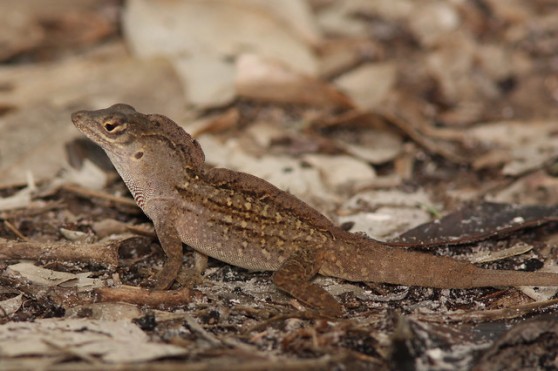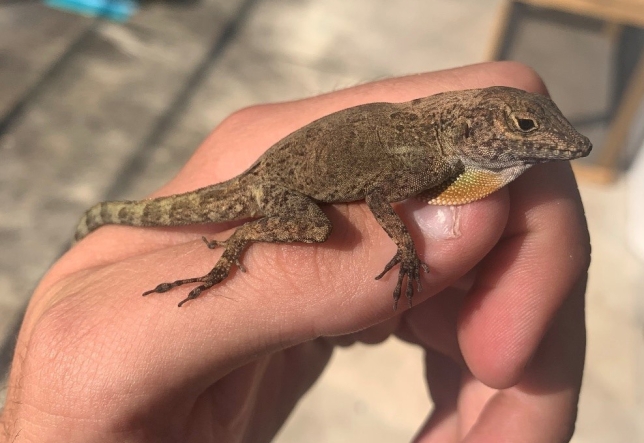Author: Amanda West
Florida’s warm winters make it an ideal place for non-native reptiles to survive when transplanted here. When a new species gains a foothold in south Florida, it may continue spreading northward, a process known as ‘secondary dispersal’. In March, Archbold Biological Station researchers caught a small lizard making just such a move.
Highlands County residents are likely familiar with the abundant non-native Brown Anoles (Anolis sagrei), as well as our native Green Anoles (Anolis carolinensis). When sharp-eyed Archbold intern Garrett Lawson noticed a unique-looking anole on the Station veranda, “I quickly grabbed it to take a closer look. With the help of expert Kenneth Krysko at the Florida Museum of Natural History, we confirmed it was not a Brown Anole and was in fact a male Crested Anole (Anolis cristatellus).” The Crested Anole is native to Puerto Rico and other Caribbean islands and looks very similar to the Brown Anole, which was introduced from Cuba in the 1940s and is very common in south Florida. According to Lawson, “Crested Anoles can be difficult to correctly identify. The crest on the backs of both Brown Anoles and Crested Anoles can be very similar. To tell them apart, I had to closely analyze the scales and toepads.” The Crested Anole was first recorded in Miami-Dade County in 1975 and was a suspected escape or release from the pet trade.
The confirmed individual at Archbold is the most northern sighting of the Crested Anole, more than 100 miles from the nearest verified specimen in Broward County. It is also the first confirmed sighting outside of Miami-Dade and Broward Counties. “Over the years, Archbold has hosted many scientific visitors from the Miami-Dade and Broward areas and we suspect that this lizard hitched a ride here in someone’s car,” says Archbold Herpetology Program Director Dr. Betsie Rothermel. “We haven’t seen any others, so we don’t think there is an established breeding population here.” For scientists studying invasion biology—and conservation managers trying to protect native wildlife—such well-documented sightings add insights regarding how introduced species spread, and why some succeed and some fail in their new environment.
You can also help add to knowledge of the distribution of non-native species. If you think you have found an exotic animal, you can report your sighting to FWC by phone at 888-Ive-Got1 or online at IveGot1.org
Clear photographs of the animal from multiple angles will help biologists identify it.
According to Florida Fish and Wildlife Conservation Commission, 88% of non-native lizards that have become established here in Florida, including the Crested Anole, come from releases or escapes from the pet trade. Released pets can start breeding and out-compete or eat native animals for food. If you have an exotic pet that you can no longer care for, bring it to one of the free Exotic Pet Amnesty Days to be adopted out. Information about Exotic Pet Amnesty Day events can be found on MyFWC.com/Nonnatives

Crested Anole, a non-native lizard captured at Archbold in March. The species is originally native to Puerto Rico and other Caribbean islands.
(Photo by Garrett Lawson)

Brown Anole, a non-native lizard introduced from Cuba in the 1940s and very common in south Florida. (Photo by Dan Irizarry)

You got these mixed up, the one on the hand is a crested and the one on the ground is a brown.
LikeLike
I actually have a crested anole who greets my cat every morning! (Thru the sliding glass door) They spend quite alot of time in each others company and wow can he show off all his back armours!!! So handsome with a personality compared to the common house lizard.
LikeLike